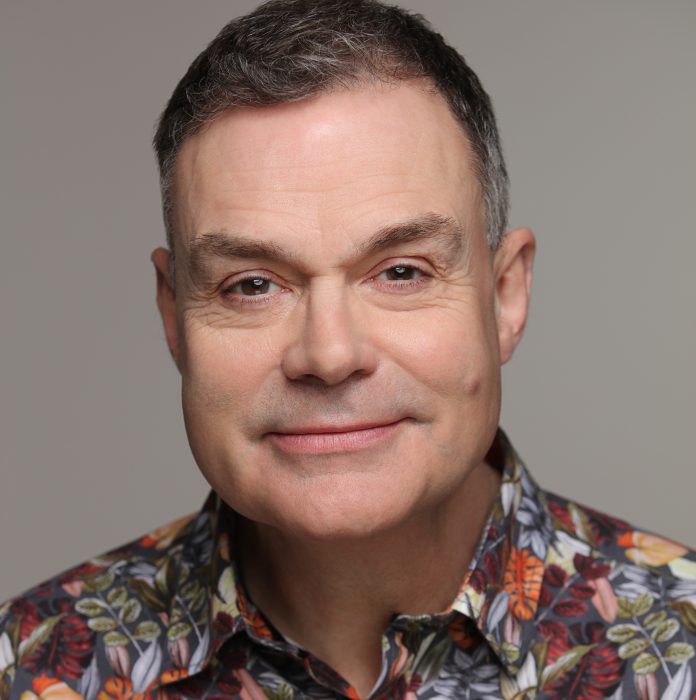By Neil Mullarkey, above
“Yes And” is the mindset of improv performers
If you’ve never seen an improv show in the theatre (or the television show, Whose Line Is It Anyway) you may not believe it possible that a whole evening could be performed this way. Together we create scenes in the moment from audience suggestions. When you have no script you really listen to your fellow player – with the intent to explicitly use what they say. We actually treat what the other person says as an ‘offer’, a gift, an invitation to build together. Imagine if you treated what others said that way – colleagues, clients, suppliers.
We never actually say the words ‘Yes And’ onstage
So you won’t to say it in real life. But it’s the intent behind all that we do. People think that improv shows are about ‘thinking on your feet’. No, it’s actually ‘listening on your feet’ and actively moving things forward with the other person’s idea. And guess what? It’s contagious. They treat what you say as an offer. We say, ‘follow the follower’.
We know that at any point the scene could go virtually anywhere. We are not thinking, ‘I want to be the funniest’. Maybe the typical business parallel to this might be ‘I am the most right’ or ‘I have the best ideas’. We are feeling our way towards what can help the scene, but only one step at a time. We move forward together, building momentum with the other person’s idea or perspective. It’s really about saying, ‘I get what you just said. I am going to use that in my response.’
Many people have this ‘Yes And’ mindset who’ve never heard of improv
We don’t have a monopoly on this practical wisdom. If those two words become a stick with which to beat people, count me out. It is so much deeper than that. It’s an attitude.
At Pixar Pictures ‘Yes And’ is known as ‘Plussing’
You can’t just criticise an idea: you must add a constructive suggestion. You build on the other person’s work. This, of course, means you are talking about their notion, not criticising the person. You’re not undermining them. Separating ‘it’ from ‘you’ is always productive.
Make the other person look good
People have heard that improv is simply just about saying Yes. No. The deeper practice is ‘how do I make others look good?’ Practising saying Yes to their idea is a good drill. You make them look good by accepting and ‘plussing’ hence building upon their ideas. But in real life, you can still accept their offer without agreeing yet you acknowledge their right to say it or that they perceive things differently from you. Equally, just saying ‘Yes’ and not the ‘And’ isn’t enough either. You could still be thinking ‘no, your point of view is invalid’. Or the other side of the coin – you are just acquiescing and denying yourself agency in the conversation.
When Yes And goes wrong
I worked with a renowned management consultancy. A young associate came up to me and said, ‘Oh I know your thing. You say Yes And instead of Yes But …to get your own way.’ His thesis was that just by saying those two words, ‘Yes And’, at the start of a response the other person would be blinded to any negative intent of the rest of your contribution. I could imagine him saying …
Yes, And …that’s a bad idea
Yes And … we tried it last year
Yes And … the CEO won’t go for it
Yes And … I don’t like you.
This shows the danger of a simplistic use of ‘Yes And’. It was a perfect articulation of the very opposite of what I teach. So I am very careful nowadays as how I ask people to try out ‘Yes And’ but to think of it as just an exercise, like playing scales on the piano before you attempt the concerto, which will be more complicated. You are warming up your improv muscles.
Some examples of when to use Yes And
- In emails: These can be brusque and come across as rude. So explicitly try to pick out something good before any criticism. Notice when someone has worked hard, even if there may be some small things that need changing.
- In negotiations: repeat back what the other person said, to show you have listened and to clarify where they stand. Articulate the areas where you agree.
- In business development. Use words and phrases the would-be customer has used. You are trying to sell them what they want, not what you hope they want.
- In leadership. Encourage team members to come to you with their ideas. They may not be implementable but if you riff on the notion, they may work. And your team with keep coming to you, whereas they won’t it you keep saying, ‘yes but’ pointing out why their ideas won’t work.
- On a video call. Ask for thoughts in Chat or notice an object in someone’s background. Acknowledge them and then ask them to elaborate.
- Networking. Ask a couple of open questions and use the answers (explicitly use words or concepts you’ve been given – ‘offers’) to help them talk more about themselves. You create rapport and will never be short of something to say.
- With clients: You co-create solutions for the future, combining their knowledge with your insights.
When not to use Yes And?
There are times you need to ‘block’ someone. Maybe they are about to do something illegal or unethical or hurtful to another person. Maybe a decision has been made so there’s no point going over old ground. Or time is short. People will accept these ‘directive’ moments as long as they are not your default because you are generally more collaborative.
‘Yes And’ as a broader mindset.
When things don’t go the way you expect or a setback occurs, think of those moments as an offer… ‘Yes that has happened … ‘And here’s what we can do to move things forward’. It’s about accepting reality but not sitting back and bemoaning what could be but being nimble enough to change your plan. Guess what, if you are always looking for the ‘offer’ then you’ll spot more.
Yes And …
…you’ll have a more positive attitude on life,
… your conversations will be more fun.
 Neil Mullarkey is the author of new book , published by Kogan Page on 03 June 2023, priced £12.99.
Neil Mullarkey is the author of new book , published by Kogan Page on 03 June 2023, priced £12.99.


